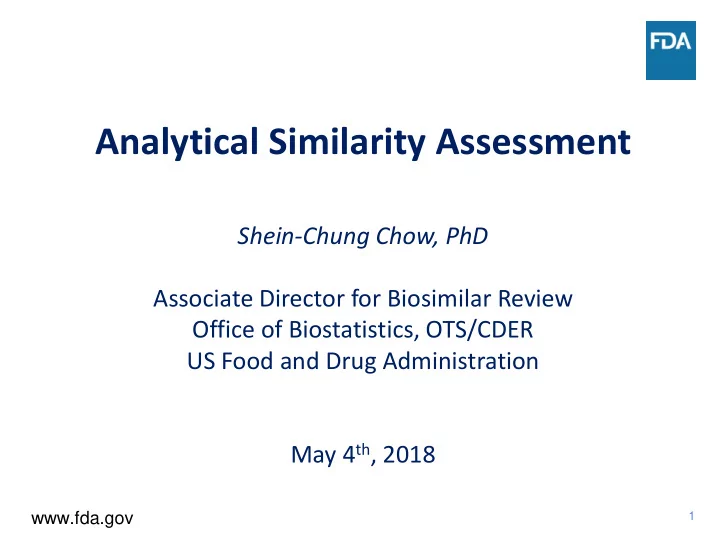

Analytical Similarity Assessment Shein-Chung Chow, PhD Associate Director for Biosimilar Review Office of Biostatistics, OTS/CDER US Food and Drug Administration May 4 th , 2018 www.fda.gov 1
Disclaimer This presentation reflects the views of the author and should not be construed to represent FDA’s views or policies. 2
Outline 3
Development of regulatory approval pathway in US • Biologics Price Competition and Innovation ( BPCI ) Act – Passed by US Congress in 2009 and enacted on March 23, 2010 • Regulatory requirements/guidance – FDA Public Hearing (November 2-3, 2010) – Various User Fees Stakeholders’ meetings within the FDA between November 2-3, 2010 and December 16, 2011 – FDA Public Meeting (December 16, 2011) – Three FDA draft guidance's (February 9, 2012; 2015) – FDA Public Hearing (May 11, 2012) – FDA draft guidance on interchangeability (January, 2017) – FDA draft guidance on analytical similarity assessment (Sept, 2017) 4
5
Stepwise approach for obtaining totality-of-the-evidence 6
Stepwise approach • Analytical studies – Critical quality attributes at various stages of manufacturing process • Animal studies – Include the assessment of toxicity • Clinical pharmacology – Include pharmacokinetics (PK) or pharmacodynamics (PD) • Additional clinical studies – The assessment of immunogenicity – Safety/tolerability – Efficacy FDA 2015 Guidance 7
8
Analytical similarity assessment • FDA recommended 3-tier approach • Classification of critical quality attributes (CQAs) into three tiers according to their criticality or risk ranking relevant to clinical outcomes • An appropriate statistical model or scoring system based on – mechanism of action (MOA) or – pharmacokinetic/pharmacodynamics (PK/PD) – Information available in the literature should be used whenever possible 9
Analytical similarity assessment • Tier 1 CQAs – Most relevant to clinical outcomes – Equivalence test • Tier 2 CQAs – Mild-to-moderate relevant to clinical outcomes – Quality range approach • Tier 3 CQAs – Least relevant to clinical outcomes – Raw data and graphical comparison 10
Same standard 90% CI for generics/biosimilars versus 95% CI for new drugs Generic/biosimilar drugs New drugs 11
12
13
14
Scientifically meaningful difference 15
Tier 2 quality range approach • Quality range set by the reference product • Derived based on population rather than population mean – We expect there are 95% (99%) of test values will fall within 2 (3) SD below and above mean • Issue regarding Tier 2 quality range approach – Especially when there is a significant mean difference between test and reference product 16
Tier 2 quality range approach • The quality range approach is a useful method for assessing similarity of non-Tier 1 quality attributes especially when both reference and test products have similar means and variances. • In cases where there are notable differences in means and/or heterogeneity in variances, the quality range method provides non-statistician such as biologist a visual examination of the seriousness of the mean difference and/or the degree of heterogeneity in variability associated with the proposed biosimilar product for assessment of similarity. 17
Tolerance interval approach • Questions regarding tolerance interval and min-max approaches • Both methods attempt to take variability into consideration • EMA considers tolerance interval approach is acceptable 18
Sample size 19
Sample size 20
Recommend
More recommend